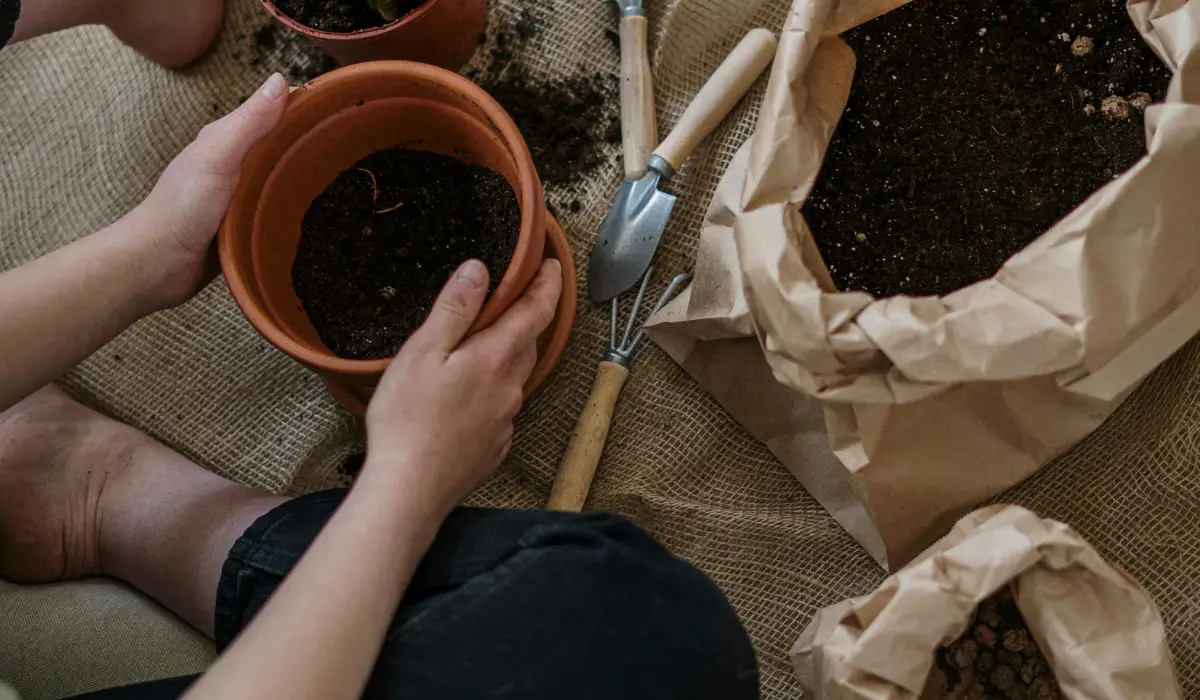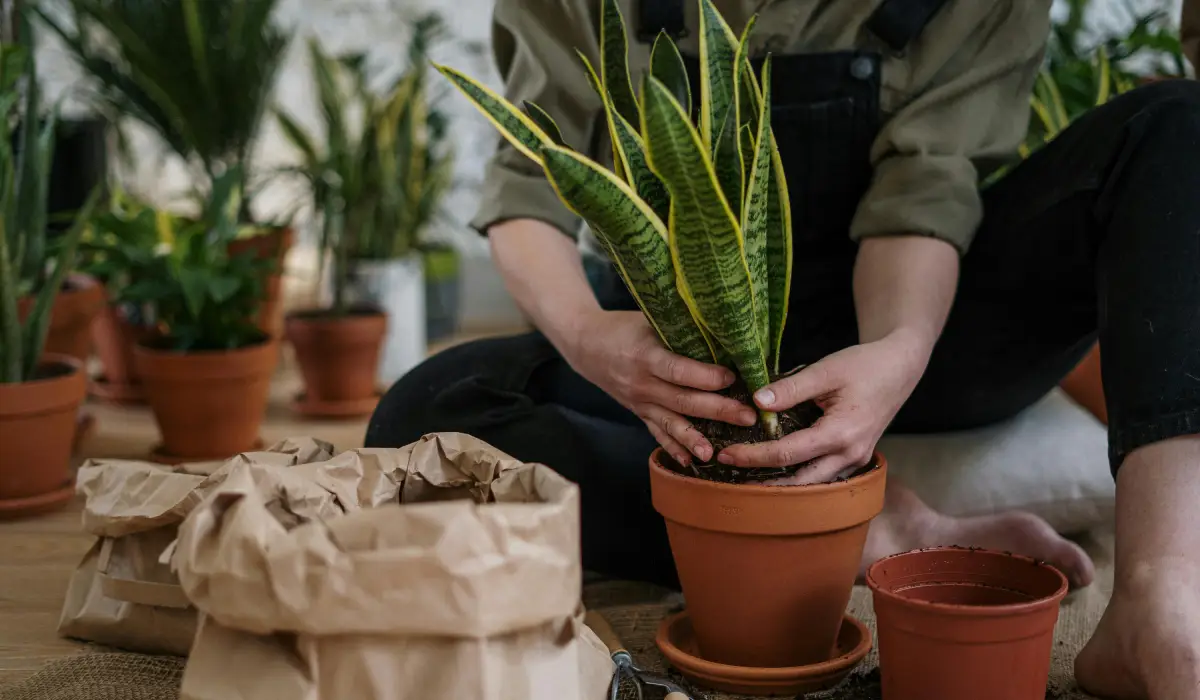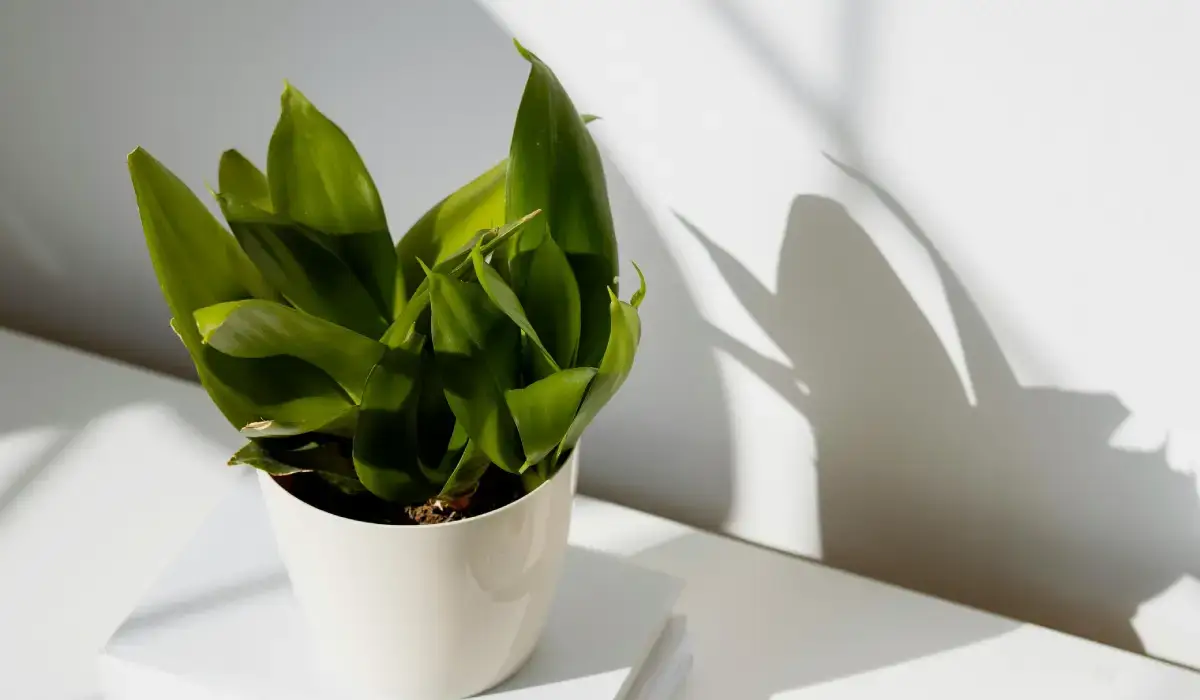Snake Plant Care Guide
If you’re about to bring home a snake plant for the first time, you might be wondering, “How do I care for a snake plant?” or “What does a snake plant need?”
Here’s something you should know first: if you’re new to plants or don’t have much time to care for them, a snake plant is the perfect choice for you.
But like any living thing, a snake plant needs a few basics to thrive and grow to its full potential. So, where do you start?
You’ll want to create a checklist of everything your new plant needs. Let’s break it down to learn about snake plant care so you can become a great caretaker!
What Kind of Soil is Needed for a Snake Plant?

Snake plants hate sitting in water. They need soil that drains quickly to avoid soggy roots. A cactus or succulent mix is ideal, as it’s specifically designed for quick drainage. If specialty soil isn’t available, you can create your own mix by combining regular potting soil with sand or perlite to enhance drainage.
Ensure the soil is light and airy—if it feels too dense, add more perlite or coarse sand to improve texture. Snake plants prefer slightly acidic to neutral soil with a pH of 6.0-7.5, which most cactus mixes naturally provide.
If you want to make your own soil mix, here’s a simple recipe:
- 2 parts potting soil
- 1 part perlite or coarse sand
- 1 part peat moss or coconut coir
This blend ensures your snake plant has the perfect balance of drainage, aeration, and nutrients for healthy growth.
How to Pot a Snake Plant?

Potting a snake plant is easy and sets it up for healthy growth. Start by choosing a pot with drainage holes—slightly larger than the plant’s roots. Fill it one-third full with the well-draining soil we discussed earlier. Place the plant in the center, spreading its roots gently. Add more soil around the roots, pressing lightly to secure it. Water lightly to help it settle, then place it in bright, indirect light. Avoid overwatering and let the soil dry out completely between waterings.
Pro Tip: If your snake plant outgrows its pot or the soil loses its quality, you’ll need to repot it. Learn all about the process in our detailed guide on How to Repot a Snake Plant.
How Often to Water a Snake Plant?

Watering is one of the easiest parts of snake plant care, but it’s also where most people go wrong. Snake plants are drought-tolerant and prefer to stay on the dry side.
Water your snake plant every 2-6 weeks, depending on the season and environment. During summer (the growing season), water every 2-3 weeks when the soil is completely dry. In winter (the dormant season), water only once a month or less, as the plant’s growth slows down. Always check the soil before watering to avoid overwatering.
How to Check if Your Snake Plant Needs Water?
- Finger test: Stick your finger 2 inches into the soil. If it feels dry, it’s time to water.
- Moisture meter: Use a moisture meter for a more accurate reading.
- Leaf check: If the leaves start to wrinkle or droop slightly, your plant may need water.
How Much Light Does a Snake Plant Need?

Snake plants are famous for their adaptability to different light conditions. This adaptability makes it an excellent choice for almost any space. However, understanding their light needs will help them thrive and grow at their best. Here’s what you need to know:
Ideal light conditions for snake plant
- Bright, indirect light: This is the best light for snake plants. Place them near an east or north-facing window where they get plenty of light without direct sun.
- Low light: Snake plants can survive in low-light areas, such as offices or rooms with small windows. However, they’ll grow slower in these conditions.
- Direct sunlight: While they can tolerate some direct sunlight, too much can scorch their leaves. If you notice brown spots, move the plant to a shadier spot.
What is the Best Fertilizer for Snake Plants?
All kinds of snake plants are low-maintenance and don’t need frequent fertilizing, but a little nutrient boost during the growing season can help them thrive. Use a balanced, water-soluble fertilizer (e.g., 10-10-10 or 20-20-20), diluted to half strength, to avoid over-fertilizing.
For a new snake plant, wait 4-6 weeks after potting before giving the first fertilizer to let it settle. After that, fertilize once every 2-3 months during the growing season (spring and summer). Avoid fertilizing in fall and winter when the plant is dormant.
What Temperature is Best for Snake Plants?
Despite their hardy and adaptable nature, you have to keep them in a preferred temperature range for your snake plant care. Snake plants prefer temperatures between 60-85°F (15-29°C) but can tolerate short periods as low as 50°F (10°C) or as high as 90°F (32°C).
To keep your plant healthy, avoid cold drafts from windows or AC vents in winter and protect it from extreme heat in summer. Snake plants thrive in average indoor temperatures.
What Humidity is Best for Snake Plants?
Snake plants can handle a wide range of humidity levels, but understanding their preferences will help them thrive. Snake plants prefer average indoor humidity (around 40-50%) but can tolerate low humidity (as low as 20%) and even higher humidity levels, making them versatile for most homes. In dry environments, they do just fine without extra humidity.
If your home is very humid, ensure proper air circulation to prevent mold or fungal issues. Avoid misting snake plants, as they don’t need extra moisture on their leaves.
Common Snake Plant Problems and Solutions
Even though snake plants are tough, they can still face a few issues. Here’s how to identify and fix common problems to keep your plant healthy and thriving:
1. Yellow leaves
Cause: Yellow leaves are usually a sign of overwatering.
Solution:
- Let the soil dry out completely before watering again.
- Check the roots for rot—if they’re mushy, trim the damaged parts and repot the plant in fresh, well-draining soil.
- Adjust your watering schedule to every 2-6 weeks, depending on the season.
Pro Tip: Use a moisture meter or your finger to check the soil’s dryness before watering.
2. Brown tips
Cause: Brown tips can result from low humidity, fluoride in tap water, or salt buildup in the soil.
Solution:
- Use filtered or distilled water to avoid chemicals found in tap water.
- Increase humidity by misting the leaves occasionally or placing a humidity tray nearby.
Pro Tip: Flush the soil with water every few months to remove excess salts from fertilizers.
3. Pests
Cause: Snake plants can occasionally attract pests like spider mites or mealybugs, especially in dry conditions.
Solution:
- Wipe the leaves with a damp cloth to remove dust and pests.
- For stubborn infestations, use insecticidal soap or neem oil. Apply it to the leaves and stems, focusing on the affected areas.
- Keep the plant in a well-ventilated area to prevent pests from returning.
Pro Tip: Regularly inspect your plant for early signs of pests, such as webbing or white cotton-like spots.
Final Takeaways
Snake plants are more than just a pretty face—they’re a low-maintenance, air-purifying powerhouse that can thrive in almost any environment. Snake plant care is simple and rewarding whether you’re a seasoned plant parent or a beginner.
By following this easy checklist, you’ll ensure your snake plant stays healthy, vibrant, and thriving for years to come. Whether you’re a seasoned plant parent or just starting, snake plants are a hassle-free way to bring greenery and positivity into your space.
Ready to become a snake plant pro? Don’t forget to explore our other guides for more plant care inspiration!
FAQs
While snake plants are hardy, they still need some light to thrive. Complete darkness will eventually cause them to weaken and stop growing.
Yellow leaves are usually a sign of overwatering or poor drainage. Snake plants store water in their leaves and prefer dry conditions. To fix this:
- Let the soil dry out completely before watering again.
- Check the roots for rot—if they’re mushy, trim the damaged parts and repot the plant in fresh, well-draining soil.
- Adjust your watering schedule to every 2-6 weeks, depending on the season.
No, snake plants have shallow root systems and do well in wide, shallow pots. A pot that’s slightly larger than the root ball is ideal. Ensure the pot has drainage holes to prevent waterlogging.
Snake plants are sensitive to cold and can suffer damage if exposed to temperatures below 50°F (10°C). In colder climates, keep them indoors during winter and away from cold drafts or windows.
Over-fertilizing can lead to salt buildup in the soil, causing brown leaf tips. Flush the soil with water to remove excess fertilizer.
Spider mites can be treated with a few simple steps:
- Wipe the leaves with a damp cloth to remove dust and pests.
- Spray the plant with a mixture of water and mild soap or use neem oil for a natural solution.
- Improve air circulation around the plant to prevent future infestations.
Yes, but only in warm climates (USDA zones 9-11).
